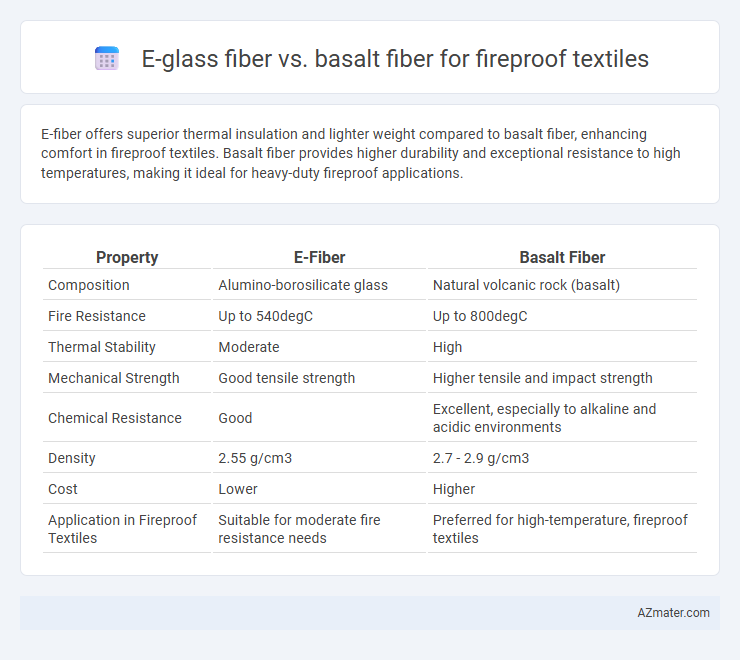E-fiber offers superior thermal insulation and lighter weight compared to basalt fiber, enhancing comfort in fireproof textiles. Basalt fiber provides higher durability and exceptional resistance to high temperatures, making it ideal for heavy-duty fireproof applications.
Table of Comparison
| Property | E-Fiber | Basalt Fiber |
|---|---|---|
| Composition | Alumino-borosilicate glass | Natural volcanic rock (basalt) |
| Fire Resistance | Up to 540degC | Up to 800degC |
| Thermal Stability | Moderate | High |
| Mechanical Strength | Good tensile strength | Higher tensile and impact strength |
| Chemical Resistance | Good | Excellent, especially to alkaline and acidic environments |
| Density | 2.55 g/cm3 | 2.7 - 2.9 g/cm3 |
| Cost | Lower | Higher |
| Application in Fireproof Textiles | Suitable for moderate fire resistance needs | Preferred for high-temperature, fireproof textiles |
Introduction to Fireproof Textile Materials
E-fiber and basalt fiber are both prominent materials used in fireproof textiles due to their exceptional thermal resistance and durability. E-fiber, commonly known as fiberglass, offers high tensile strength and excellent insulation properties, making it suitable for protective clothing and fire barriers. Basalt fiber, derived from volcanic rock, provides superior resistance to high temperatures, chemical corrosion, and thermal shock, enhancing safety in fireproof applications.
Overview of E-fiber: Properties and Applications
E-fiber, also known as E-glass fiber, offers high tensile strength, excellent electrical insulation, and resistance to heat up to 540degC, making it ideal for fireproof textiles. Its lightweight structure and corrosion resistance enhance durability in harsh environments, commonly used in reinforcement for composites, insulation materials, and fire-resistant fabrics. E-fiber's thermal stability and mechanical robustness provide critical performance advantages in aerospace, automotive, and construction industries requiring fireproof solutions.
Basalt Fiber: Composition and Key Characteristics
Basalt fiber, derived from volcanic basalt rock, is composed primarily of silica, alumina, and various oxides, providing exceptional heat resistance and mechanical strength. These inorganic fibers withstand temperatures exceeding 600degC, making them ideal for fireproof textiles used in protective clothing and insulation. Compared to E-fiber glass, basalt fiber offers superior chemical stability, higher thermal resistance, and enhanced durability in extreme fire exposure scenarios.
Fire Resistance Performance: E-fiber vs Basalt Fiber
Basalt fiber exhibits superior fire resistance compared to E-fiber, maintaining structural integrity at temperatures exceeding 1000degC, while E-fiber typically begins to degrade around 600degC. Basalt fiber's natural mineral composition provides enhanced thermal stability and non-flammability, making it ideal for fireproof textile applications. E-fiber, derived from glass, offers moderate fire resistance but lacks the high-temperature endurance and charring resistance of basalt fiber.
Mechanical Strength Comparison
E-glass fiber exhibits tensile strengths typically around 3.4 GPa, making it a strong candidate for fireproof textiles where mechanical durability is crucial. Basalt fiber offers superior mechanical properties with tensile strengths ranging between 2.8 and 4.8 GPa, often surpassing E-glass in impact resistance and durability under high-temperature conditions. Both fibers provide excellent fire resistance, but basalt fiber's enhanced mechanical strength and thermal stability make it more suitable for applications demanding higher structural integrity in fireproof textiles.
Thermal Insulation Capabilities
E-fiber exhibits exceptional thermal insulation capabilities due to its low thermal conductivity and high melting point, making it highly effective for fireproof textile applications requiring rapid heat resistance. Basalt fiber offers superior thermal stability and retains insulating properties at elevated temperatures up to 870degC, providing enhanced durability in fireproof textiles exposed to extreme heat. Compared to basalt fiber, E-fiber provides lightweight insulation with faster heat dissipation, whereas basalt fiber excels in prolonged fire exposure scenarios due to its chemical inertness and structural integrity.
Durability and Chemical Resistance
E-glass fiber exhibits superior durability and excellent chemical resistance, making it highly effective for fireproof textile applications that demand long-term performance and exposure to harsh environments. Basalt fiber offers outstanding thermal stability and corrosion resistance, particularly excelling in maintaining structural integrity under extreme fire conditions and various chemical exposures. Both fibers provide significant advantages, with E-glass favoring mechanical durability and chemical inertness, while basalt fiber delivers enhanced heat resistance and robustness against chemical degradation.
Environmental Impact and Sustainability
E-fiber offers lightweight fireproof properties with lower production emissions compared to basalt fiber, which requires energy-intensive mining and melting of volcanic rock, increasing its carbon footprint. Basalt fiber is naturally abundant and non-toxic, providing excellent biodegradability and recycling potential, whereas E-fiber relies on synthetic polymers derived from fossil fuels. Choosing between E-fiber and basalt fiber for fireproof textiles involves balancing the reduced environmental impact of E-fiber's manufacturing process against basalt fiber's natural origin and stronger sustainability credentials.
Cost Analysis and Market Availability
E-fiber offers a lower initial cost and wider market availability compared to basalt fiber, making it a preferred choice for budget-conscious fireproof textile manufacturers. Basalt fiber, while more expensive due to its raw material extraction and production process, provides superior thermal resistance and durability. Market demand for E-fiber remains strong in large-scale industrial applications, but basalt fiber is gaining traction in niche sectors requiring premium fireproof performance.
Conclusion: Choosing Between E-fiber and Basalt Fiber
E-fiber offers excellent electrical insulation and lightweight properties, making it suitable for specialized fireproof textile applications with moderate thermal resistance. Basalt fiber surpasses E-fiber in heat resistance, durability, and environmental sustainability, making it ideal for high-temperature fireproof textiles. Selecting between E-fiber and Basalt fiber depends on specific fire protection requirements, mechanical performance, and eco-friendly considerations for the intended application.

Infographic: E-fiber vs Basalt fiber for Fireproof textile
 azmater.com
azmater.com